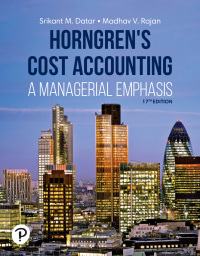Cathy Jeffries operates Relaxing Day, a day spa with 15 employees. Jim Ryan has recently been hired
Question:
Cathy Jeffries operates Relaxing Day, a day spa with 15 employees. Jim Ryan has recently been hired by Jeffries as a controller. Relaxing Day’s previous accountant had done very little in the area of variance analysis, but Ryan believes that the company could benefit from a greater understanding of its business processes. Because of the labor-intensive nature of the business, he decides to focus on calculating labor variances.
Ryan examines past accounting records, and establishes some standards for the price and quantity of labor. While Relaxing Day’s employees earn a range of hourly wages, they fall into two general categories: skilled labor, with an average wage of $30 per hour, and unskilled labor, with an average wage of $12 per hour. The average spa treatment requires 5 hours and typically requires a combination of 4 skilled hours and 1 unskilled hour.
Actual data from last month, when 800 spa treatments were completed, are as follows:

Looking over last month’s data, Ryan determines that Relaxing Day’s labor price variance was $632 favorable, but the labor efficiency variance was $1,524 unfavorable. When Ryan presents his findings to Jeffries, the latter is furious. “Do you mean to tell me that my employees wasted $1,524 worth of time last month? At closer look, the skilled labor wasted more time than the unskilled labor who are paid less. I’ve had enough. They had better shape up, or else!” Ryan tries to calm her down, saying that in this case the efficiency variance does not necessarily mean that employees were wasting time. Ryan tells her that he is going to perform a more detailed analysis, and will get back to her with more information soon.
Required
1. What is the budgeted cost of direct labor for 800 spa treatments?
2. How were the $632 favorable price variance and the $1,524 unfavorable labor efficiency variance calculated? What was the company’s flexible-budget variance?
3. What do you think Ryan meant when he said that “in this case the efficiency variance does not necessarily mean that employees were wasting time”?
4. For the 800 spa treatments performed last month, what is the actual direct labor input mix percentage? What was the standard mix for direct labor?
5. Calculate the total direct labor mix and yield variances.
6. How could these variances be interpreted? Did the employees waste time? Upon further investigation, Ryan discovers that there were some unfilled vacancies last month in the unskilled labor positions that have recently been filled. How will this new information likely impact the variances going forward?
Step by Step Answer:

Horngrens Cost Accounting A Managerial Emphasis
ISBN: 9780135628478
17th Edition
Authors: Srikant M. Datar, Madhav V. Rajan





